Hip Dysplasia in Dogs
HIP DYSPLASIA IN DOGS
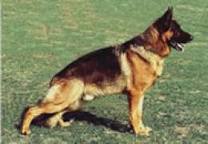
Hip dysplasia is mainly a problem in medium to large breed dogs. The dog breeds most commonly affected are the German Shepherd, Labrador Retriever, St. Bernard and Golden Retriever. It is also becoming more prevalent in certain breeds such as the Rottweiler and the Border Collie. Certain kennel clubs and federations have taken great steps with breeding programmes to reduce the incidence of hip dysplasia in puppies that are registered and tested for the problem. The main problem lies in backyard breeders and people that have a litter at home with their dogs as they may not be aware of, or test for hip dysplasia.
WHAT IS HIP DYSPLASIA?
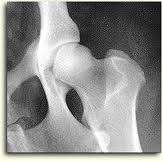
Hip dysplasia is a problem with the ball and socket joint of the hip. The ball should sit snugly in the socket, and be able to rotate easily and glide smoothly within the joint. The ball is kept in place by a central ligament in the middle of the ball which attaches it to the pelvis. But it is also held in place by fitting very snuggly into the joint.
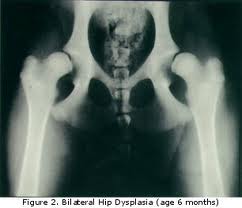
With hip dysplasia, the ball is not perfectly round and the socket may be flatter than normal – in other words, the shape has changed of both the ball and the socket and they do not fit snuggly together any more. When the dog moves the back legs the ball is not properly supported and bounces around inside the hip joint, hitting up against the edges of the pelvic rim. Over time this turns into arthritis due to excessive wear and tear of an unstable joint. In severe cases the owners notice weakness of the back legs from a few months of age, but in milder cases the first sign may be early onset arthritis at the age of about 6 years.

WHAT CAUSES HIP DYSPLASIA ?
There are many factors that lead to the development of hip dysplasia.
- Genetic – it can be passed on from the parents on both sides and thus they should always be tested and hip scored before breeding. Merely saying that they seem healthy and have never had any problems is not enough as hip dysplasia can only show up after the age of 5 years.
- Nutritional – Too much calcium in the diet can lead to fast growth of the bones and the joints not forming properly. For this reason you should never put a large breed puppy on a calcium supplement. Feed a puppy food for large breed puppies – these will have the correct balance of calcium and phosphate for the growing bones, and these foods also have the correct amount of protein in them so the bone growth is slowed so the bones have time to form correctly.

Feeding a large breed puppy food will help prevent bad hip dysplasia - Exercise – too much exercise too early can promote hip dysplasia in a joint that has the tendency to develop it already. Puppies up to the age of six months should not be running a few miles daily – it’s too much. These pups should really be only going out to the park or doing less than 1 mile daily until they are old enough.
HOW DO WE DIAGNOSE HIP DYSPLASIA ?
At the moment there isn’t a blood test for hip dysplasia as there are so many factors that affect whether it develops in a predisposed dog or not. The test that is routinely run by proper breeder is x rays that are done on young adult dogs destined for breeding. Their hips are x rayed under general anaesthetic and sent off to a specialist for grading. International hip score grading has change in the past 5 years. Hips used to be graded from 0-4, with 0 being non-existent and 4 being severely dysplastic hips with the ball often lying outside the hip joint altogether. The newer classification classifies the degree of hip dysplasia according to an alphabetic classification, A, aa, aa, b etc.
X rays must be taken under deep sedation or general anaesthetic as the dog’s legs must be straightened out completely and most animals will tend to withdraw the legs if pulled on if they are awake or lightly sedated.
At Cornell university, researchers at Cornell University have developed a new test known as the DLS test for canine hip dysplasia known as the dorsolateral subluxation (DLS) test. It in considered to be more accurate at a younger age than the traditional test. While the traditional OFA test is not accurate before 2 years of age, the DLS test can be accurate as early as 8 months of age. In the DLS test the dog is positioned differently and in a more natural position and thus none of the normal changes seen in hip dysplasia are hidden. The dog is placed on its stomach on a foam rubber pad. There is a hole cut in the pad for the dog’s hind legs. The stifles (or knees) touch the table, and the dog’s femurs are nearly perpendicular to the table. Arranging the dog in a position that mimics its natural posture allows the x-ray to show accurately what the position of the hip joints is. (*2)
THE BRITISH CLASSIFICATION
The British Veterinary Association uses the following criteria to determine hip score:
Norberg Angle – the angle of the hip joint when the animal is lying down
Subluxation – how much the ball pops out of the socket
Cranial Acetabular Edge – the front edge of the socket – any arthritic change or rounding
Dorsal Acetabular Edge – the top rim of the socket – is it smooth and circular and any arthritic changes
Cranial Effective Acetabular Rim the front rim of the socket – any arthritis changes or rounding off
Acetabular Fossa – is it normal smooth and a normal shape
Caudal Acetabular Edge – the back edge of the socket – is it smooth or rounded and any arthritic changes
Femoral Head/Neck Exostosis – any arthritis round the top part of the leg bone or femur
Femoral Head Recontouring – the shape of the femur head – it should be perfectly round.
The lower the score, the less the degree of dysplasia present. The minimum (best) score for each hip is zero and the maximum (worst) is 53, giving a range for the total of 0 to 106. Each hip is scored separately under the BVA, so within the UK scores are usually displayed as two numbers separated by a forward slash (e.g. 2/6). The scores are combined to provide a score for international comparison.
INTERNATIONAL HIP SCORING
| OFA (USA) | FCI (European) | BVA (UK/Australia) | SV (Germany) |
| E | A-1 | 0-4 (no > 3/hip) | Normal |
| G | A-2 | 5-10 (no > 6/hip) | Normal |
| F | B-1 | 11-18 | Normal |
| B | B-2 | 19-25 | Fast Normal |
| M | C | 26-35 | Noch Zugelassen |
| Mod | D | 36-50 | Mittlere |
| S | E | 51-106 | Schwere |
(*1)
SIGNS OF HIP DYSPLASIA
- Reluctance or difficulty in getting up from a lying position
- Swaying hindquarters when the dog walks and legs held close together
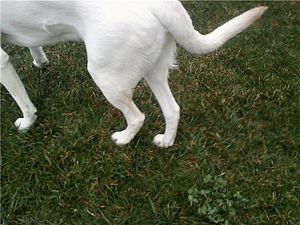
The legs held close together in a young dog with hip dysplasia as the joints are unstable - A rump that is very sloped in some breeds often corresponds with hip dysplasia
- Older dogs that show stiffness in the back legs – short steps and take a long time to rise
- The legs in badly dysplastic arthritic joints cannot be pulled backwards
- Painful hips and back legs
- Bunny hopping when running
- Weak thin hindquarters and muscles forequarters
- Aversion to or lameness after heavy exercise
TREATMENT FOR HIP DYSPLASIA
There are numerous options for managing and treating hip dysplasia out there. What is best for your pet depends on how severely your pet is affected, his or her age, your budget, whether or not your pet in insured or not, the weight of your pet , whether one or both sides are affected and whether your pet has healthy joints (other than the hips ) in his or her legs.
IN THE FIRST YEAR:
TO REDUCE THE CHANCES OF YOUR PET GETTING HIP DYSPLASIA:
- Feed the correct diet – for bigger breed puppies, you will need to feed a large breed puppy food which has the correct balance of calcium, phosphorus and protein to allow young bones to grow slowly and properly.
- Limit exercise. Once your puppy has had the final puppy vaccine and waited two weeks, he is allowed to go out for exercise. Playing or walking in the park is fine but at this young age, your puppy shouldn’t be running a couple of miles. It’s too much.
- Buy your puppy from breeders who can provide you with copies of the hip scores done by a certified radiologist for both parents. If you get a puppy whose parents haven’t been tested, you are taking a chance. Even if the parents look fine or the vet has felt the hips, hip dysplasia can only show after the age of 5 years and younger parents may appear to be healthy but actually have bad hips.
- If your puppy is showing any of the signs of hip dysplasia you can ask your vet to do an x ray of your dog’s hips. This is only useful in older puppies – over 6 months. This wouldn’t be for certification, but to pick it up early and institute treatment as soon as possible. For certification, puppies should be over a year and in some breeds, 18 month of age.
TREATMENT FOR DOGS WITH HIP DYSPLASIA
There are both surgical and medical options available. Severely affected dogs often need surgery. In early or mild cases, or cases in which the owners have opted against surgery, medical management is warranted.
MEDICAL MANAGEMENT
This manages the mobility and pain seen with hip dysplasia but isn’t a cure so often are things that continue for the remainder of the dog’s life.
- Joint supplements – chondroitin, glucosamine and green lipped mussel extract are examples of natural supplements that help cartilage cope with the extra stress that happens within the dysplastic hip joint. They are very mild anti inflammatories and work best if given for more than 8 weeks. Dogs start on a double dose for the first 6 weeks then go onto a maintenance dose.
- Pentosan polysulphate – injections given regularly into the muscle can act similarly to the oral joint supplements but faster, so that in severe disease the two can be combined.
- Painkillers and anti inflammatories. These are generally used in older dogs where the hip joint has already become arthritic and they are struggling to walk. They can be used every day but do carry certain side effects – they can affect the stomach lining and cause ulcers if given on an empty tummy and in high doses can affect kidney function. For this reason, your vet should recommend a blood or urine test before starting these meds on the long term to make sure they are safe for your pet.
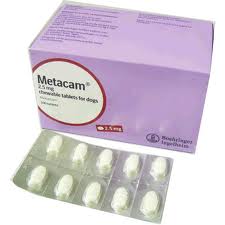
Meloxicam is a painkiller used to manage the pain associated with hip problems - Special diets – Mobility (Royal Canin) and j/d (joint diet made by Hills Science Plan ) are two foods with special additives that you feed to your dog every day to improve mobility over the long term. Most people have good results on them.

Royal Canin mobility food can greatly improve mobility in these dogs over the long term - Swimming and hydrotherapy. Dogs with hip dysplasia often benefit enormously from hydrotherapy – swimming physiotherapy for dogs.
- Weight control – this is the most important way to control the signs of hip dysplasia in dogs. Lose the weight and the mobility will increase – it’s that simple. Dogs are placed onto a strict diet and a certain amount of exercise must be done as well – dogs should walk on grass surfaces and on flat areas twice daily or swim to keep the muscles round the hip strong and the hip joint mobile.
- Keep the dog warm and use heat therapy on sore joints – hot water bottle, wheat germ pillows and infa red lighting can all help to control pain. Always test it on your own skin first.
- Soft bedding is very important.
- Avoid slippery floors.
SURGICAL TREATMENT
Some surgery can be curative and others help to control the dysplasia and pain.
- Total hip replacement – the gold standard for correcting hip dysplasia in fully grown adult dogs – the hip joint is replaced with a titanium joint – both the ball and the top of the socket are titanium. Works very well. The only type of dog that it may cause problems with is a dog that is extremely hyperactive. All dogs should be confined or be on strict lead walks for up to 12 weeks after the surgery to allow it to heal. I have seen a dog break its implant after it cleared a 6 foot wall soon after surgery. Only 1 side can be done at a time. The most costly operation to do and specialist work.
- Triple pelvic osteotomy – for young growing dogs with severe early onset hip dysplasia. The pelvic is entirely reshaped to create a functional deep socket for the ball to sit in. These dogs do very well but, as with the total hip replacement, dogs should be confined and on limited leash walks for up to 3 months post surgery. Only 1 side can be done at a time. Costly and specialist work.
- Femur head removal. A salvage procedure. Can be performed by most vets. The ball is removed so it doesn’t rub in the socket, taking the pain away. This improves the quality of life. Only recommended for cats, small to medium dogs of normal weight as the leg is not as strong and thus quite a lot of stress is put onto the other leg which in a large dog can lead to premature ageing of the opposite hip joint. If the opposite hip joint is also very dysplastic, it is not recommended.
- Pectineal tendonotomy – the muscle on the inside of the leg that tends to pull the hip joint out is cut. It works well for a short time and is cheap to do and any vet can perform it, but only lasts a few months as the scar tissue that forms tend to have the same effect. An old fashioned procedure.
REFERENCES
- http://en.wikipedia.org/wiki/Hip_score
- http://bakerinstitute.vet.cornell.edu/animalhealth/page.php?id=1104

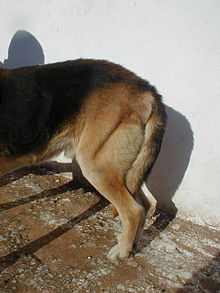
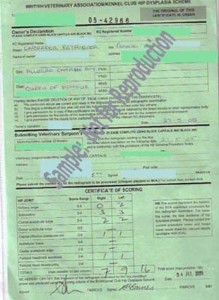
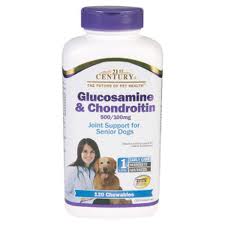
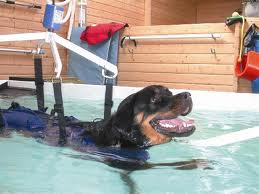


Leave a Reply
You must be logged in to post a comment.